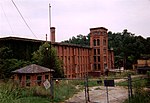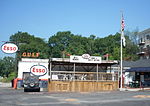Issaqueena Bombing Range
Airfields of the United States Army Air Forces in South CarolinaBombing rangesGeography of Pickens County, South Carolina

The Issaqueena Bombing Range was a World War II target range used for training flight crews from Greenville Army Air Base, later renamed Donaldson Air Force Base. The Army Air Field was established in 1942 for the preparation of aircrew using North American B-25 Mitchell twin-engine bombers, and a suitable target area was established using Lake Issaqueena, northwest of Calhoun, South Carolina and Clemson University, completely within the Clemson Experimental Forest. Bombing Range Road is still located off of State Highway S-39-291, southwest of Six Mile, South Carolina and west of Lake Issaqueena.
Excerpt from the Wikipedia article Issaqueena Bombing Range (License: CC BY-SA 3.0, Authors, Images).Issaqueena Bombing Range
Issaqueena Lake Trail,
Geographical coordinates (GPS) Address Nearby Places Show on map
Geographical coordinates (GPS)
| Latitude | Longitude |
|---|---|
| N 34.740833333333 ° | E -82.861388888889 ° |
Address
Issaqueena Lake Trail
Issaqueena Lake Trail
29665
South Carolina, United States
Open on Google Maps







